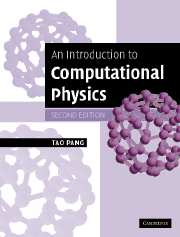Book contents
- Frontmatter
- Contents
- Preface to first edition
- Preface
- Acknowledgments
- 1 Introduction
- 2 Approximation of a function
- 3 Numerical calculus
- 4 Ordinary differential equations
- 5 Numerical methods for matrices
- 6 Spectral analysis
- 7 Partial differential equations
- 8 Molecular dynamics simulations
- 9 Modeling continuous systems
- 10 Monte Carlo simulations
- 11 Genetic algorithm and programming
- 12 Numerical renormalization
- References
- Index
2 - Approximation of a function
Published online by Cambridge University Press: 05 June 2012
- Frontmatter
- Contents
- Preface to first edition
- Preface
- Acknowledgments
- 1 Introduction
- 2 Approximation of a function
- 3 Numerical calculus
- 4 Ordinary differential equations
- 5 Numerical methods for matrices
- 6 Spectral analysis
- 7 Partial differential equations
- 8 Molecular dynamics simulations
- 9 Modeling continuous systems
- 10 Monte Carlo simulations
- 11 Genetic algorithm and programming
- 12 Numerical renormalization
- References
- Index
Summary
This chapter and the next examine the most commonly used methods in computational science. Here we concentrate on some basic aspects associated with numerical approximation of a function, interpolation, least-squares and spline approximations of a curve, and numerical representations of uniform and other distribution functions. We are only going to give an introductory description of these topics here as a preparation for other chapters and many of the issues will be revisited in a greater depth later. Note that some of the material covered here would require much more space if discussed thoroughly. For example, complete coverage of the issues involved in creating good random-number generators could form a separate book. Therefore, we only focus on the basics of the topics here.
Interpolation
In numerical analysis, the results obtained from computations are always approximations of the desired quantities and in most cases are within some uncertainties. This is similar to experimental observations in physics. Every single physical quantity measured carries some experimental error. We constantly encounter situations in which we need to interpolate a set of discrete data points or to fit them to an adjustable curve. It is extremely important for a physicist to be able to draw conclusions based on the information available and to generalize the knowledge gained in order to predict new phenomena.
Interpolation is needed when we want to infer some local information from a set of incomplete or discrete data.
Information
- Type
- Chapter
- Information
- An Introduction to Computational Physics , pp. 16 - 48Publisher: Cambridge University PressPrint publication year: 2006
